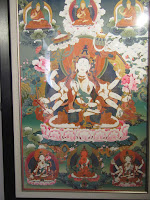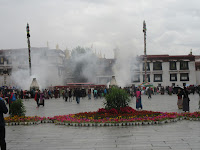 Our first stop of the day was the
Traditional Tibetan Hospital. We climbed three flights of stairs to hear Dr.
Tsewang describe traditional Tibetan medicine. He used diagrams painted in the
traditional Thangka style – which we would learn more about later – to describe
the three spirits that govern the health of the body. The diagrams portray the
body as analogous to a tree. The main trunk of the tree is healthy; diseases
are represented by branches that separate from the main trunk. Each of the
three main spirits that govern disease is represented by its own color –
yellow, blue or white. The diagrams were draped in traditional read and yellow
Tibetan Buddhist fabric – the same colors that monks wear – and surrounded by
beautiful embroidery. Dr. Tsewang pointed to glass-fronted cabinets that
contain early works of Tibetan medicine, many of them printed by using wooden
blocks.
Our first stop of the day was the
Traditional Tibetan Hospital. We climbed three flights of stairs to hear Dr.
Tsewang describe traditional Tibetan medicine. He used diagrams painted in the
traditional Thangka style – which we would learn more about later – to describe
the three spirits that govern the health of the body. The diagrams portray the
body as analogous to a tree. The main trunk of the tree is healthy; diseases
are represented by branches that separate from the main trunk. Each of the
three main spirits that govern disease is represented by its own color –
yellow, blue or white. The diagrams were draped in traditional read and yellow
Tibetan Buddhist fabric – the same colors that monks wear – and surrounded by
beautiful embroidery. Dr. Tsewang pointed to glass-fronted cabinets that
contain early works of Tibetan medicine, many of them printed by using wooden
blocks. tion of the patient’s symptoms. Various herbal remedies, dietary and lifestyle counseling, and acupuncture are used. However, in Tibetan acupuncture, only the skin of the head is punctured with a needle. For medical emergencies, people should go to the modern hospital. Len separately asked Dr. Tsewang if he goes to a Tibetan doctor for treatment. The answer was no, because he does not have a chronic disease. He has, however, been to the modern hospital to treat an emergent medical condition.
 Dr. Tsewang then took us to a
separate room that is a shrine to the founders and early practitioners of
Tibetan medicine. It looked just like a shrine that you could see in a Buddhist
temple; in fact, one of the six figures represented was the Buddha himself.
Someone asked whether there is a school or college that teaches traditional
Tibetan medicine. There is such a college. Its original site was on a hill
across from the Potala Palace that is now occupied by a radio tower. It was destroyed during the peaceful liberation. It has since been
rebuilt elsewhere.
Dr. Tsewang then took us to a
separate room that is a shrine to the founders and early practitioners of
Tibetan medicine. It looked just like a shrine that you could see in a Buddhist
temple; in fact, one of the six figures represented was the Buddha himself.
Someone asked whether there is a school or college that teaches traditional
Tibetan medicine. There is such a college. Its original site was on a hill
across from the Potala Palace that is now occupied by a radio tower. It was destroyed during the peaceful liberation. It has since been
rebuilt elsewhere.
The twenty of us, with our two
guides and driver, then hopped on the bus and drove to the square in front of
the Jokhang Temple, the most sacred building in Tibet. The temple was built in
the seventh century by Songtsen Gampo. The site was selected by Queen
Wengcheng, a princess from China who became his second wife. His first wife,
Princess Bhrikuti of Nepal, financed the construction. In her honor, the main
gate faces west toward Nepal. Our guide, Nima, reported that the Temple was
saved from destruction during the Cultural Revolution, although Fodor’s reports
that it was ransacked by the Red Guards in the 1960’s and turned into a pig
sty. It has since been restored to its former glory.
The first thing we noticed upon
disembarking from the bus was smoke from two egg-shaped furnaces in front of
the temple. People were stoking juniper branches into them; the smoke wafting
skyward was an offering to the Buddha. Men dressed in orange clothing were
making sure the juniper burned by using fossil-fuel fire starters. Next to each
furnace was a prayer pillar wrapped in prayer flags that carried the prayers of
the faithful about 40 feet skyward. Nima reported that those prayer flags are
changed one a year during a religious holiday. In the courtyard immediately in
front of the temple people were ritually prostrating themselves over and over
again on mats they had brought. Some even had pads to cushion their hands from
contact with the stones. One woman inside the temple wore a pair of athletic
gloves to protect her hands during the prostration. Nima said that some people
would do that for a full day. It looked like a full aerobic workout – touching
the head, the chest and the stomach with one hand, then kneeling, then full
prostration, then standing up, over and over again.
Just inside the outer door of the
temple were colorful statues of four guardians from each of the four cardinal
directions. Inside the temple, the faithful walk clockwise past and through
series of chapels. They stand in line
for as long as two hours for the privilege. Nima had deliberately brought us
here on a Wednesday morning to see the pilgrimage; in the afternoon it would be
only tourists. Fortunately, the morning tourists had a separate line from the
faithful, and we were urged not to jump their line to enter into any of the
chapels. We paused by a monk who, through a wooden railing, would accept
requests for special prayers to be said by the monks, in exchange for a cash
offering. Some of those requesting prayers were mothers with tiny babies in
their arms.
The sanctum sanctorum of the
temple is the chapel called Jowo Sakyamuni Lhakhang, containing a statue of
Jowo Rimpoche, representing the Buddha (Sakyamuni) at age 12. This chapel is
packed with people coming in and out, and standing before the Buddha in
reverence. We were content merely to peek in. Many people had been in line with
thermoses of warm yak butter for the temples many yak-butter lamps. Those
thermoses were emptied along the way, but I didn’t see where.
We climbed to the second floor,
decorated in the Chinese style to honor Queen Wencheng and then to the third
floor, decorated in Nepalese style to honor Queen Bhrikuti. On the roof is a
great view of the gold decorations that top the temple and the mountains in the
distance. Not far away, the Potala Palace appeared and disappeared behind the
clouds of smoke from the juniper incense burning in the furnaces below.

Some of us shopped for a bit in
the tourist shops in the streets around the temple, then we climbed spiral
concrete steps to a second-floor restaurant. Our two main dishes were curried
yak and grilled yak, accompanied by bread, rice, noodles and spring rolls. On
the sidewalk below the restaurant was as sign welcoming us in Chinese, Tibetan
and English, to “gorgeous homeland, joyful Lhasa.”
 The bus took us to the Tibet Manla
Tundrop Tangkha Fine Arts Center in a strip mall near the Sera Monastery. There
we listened to Master Dhondup explain the traditional Tibetan art form of
Tangkha painting. Most of his works were of the Buddha, and told stories of the
Buddha’s life and teachings. In Tangkha art, the Buddha’s features are strictly
prescribed, such as the distances between eyes, nose, and mouth. One painting I
first mistook for Shiva, who is often portrayed with four or six arms. Of
course, this was not Shiva, but Buddha, and he had eight arms, corresponding
with eight-fold path.
The bus took us to the Tibet Manla
Tundrop Tangkha Fine Arts Center in a strip mall near the Sera Monastery. There
we listened to Master Dhondup explain the traditional Tibetan art form of
Tangkha painting. Most of his works were of the Buddha, and told stories of the
Buddha’s life and teachings. In Tangkha art, the Buddha’s features are strictly
prescribed, such as the distances between eyes, nose, and mouth. One painting I
first mistook for Shiva, who is often portrayed with four or six arms. Of
course, this was not Shiva, but Buddha, and he had eight arms, corresponding
with eight-fold path. We then took a walk to the Sera
monastery, a Gelugpa monastery founded in 1419. At one time it housed 5500
monks, but today only 500. Nima and Hu led us a courtyard up a steep hill, and
even steeper steps, were dozens of monks in red robes were engaged in
one-on-one debates. The monks use loud hand slaps to emphasize important points
during the debate. On the way out, guards held us back so that some tourists
could take a group photo outside the entrance. People here are very respectful
when others are taking photographs. On the way out I took a photo of a swastika
carved in the stone threshold of the debate courtyard.
We then took a walk to the Sera
monastery, a Gelugpa monastery founded in 1419. At one time it housed 5500
monks, but today only 500. Nima and Hu led us a courtyard up a steep hill, and
even steeper steps, were dozens of monks in red robes were engaged in
one-on-one debates. The monks use loud hand slaps to emphasize important points
during the debate. On the way out, guards held us back so that some tourists
could take a group photo outside the entrance. People here are very respectful
when others are taking photographs. On the way out I took a photo of a swastika
carved in the stone threshold of the debate courtyard.
After the usual supper of stir fry
at the hotel buffet, I fell into bed at 7:30 p.m. and had a good night’s sleep.





No comments:
Post a Comment